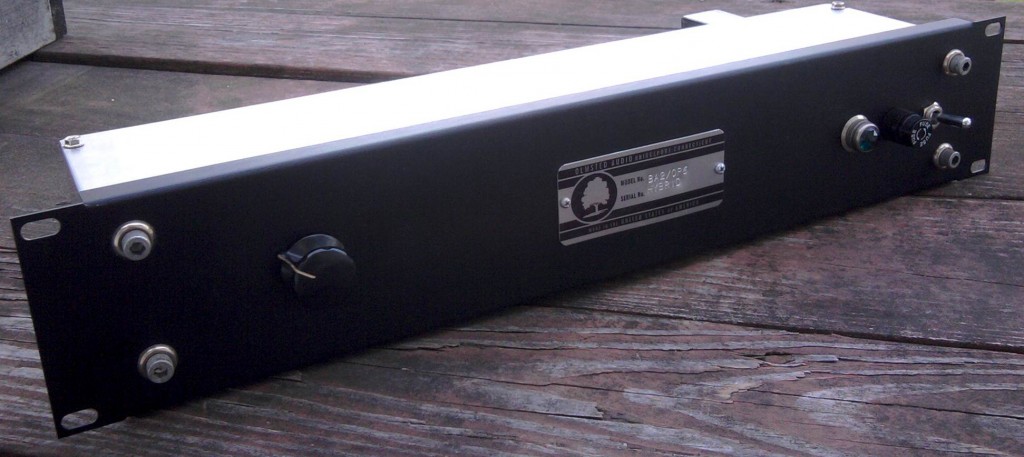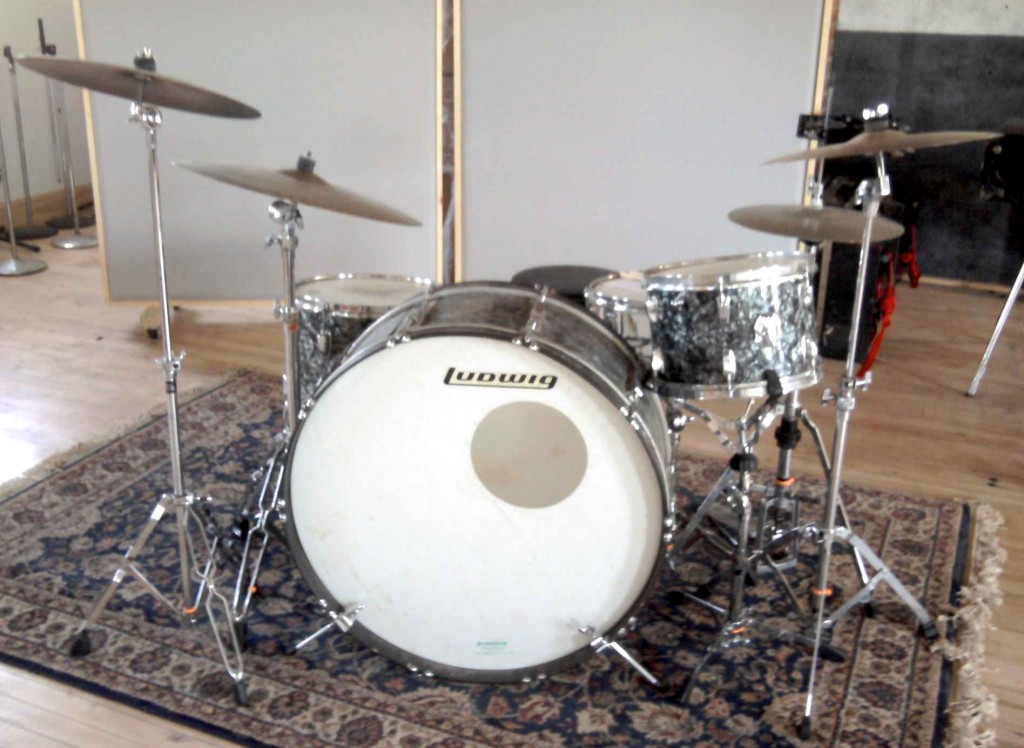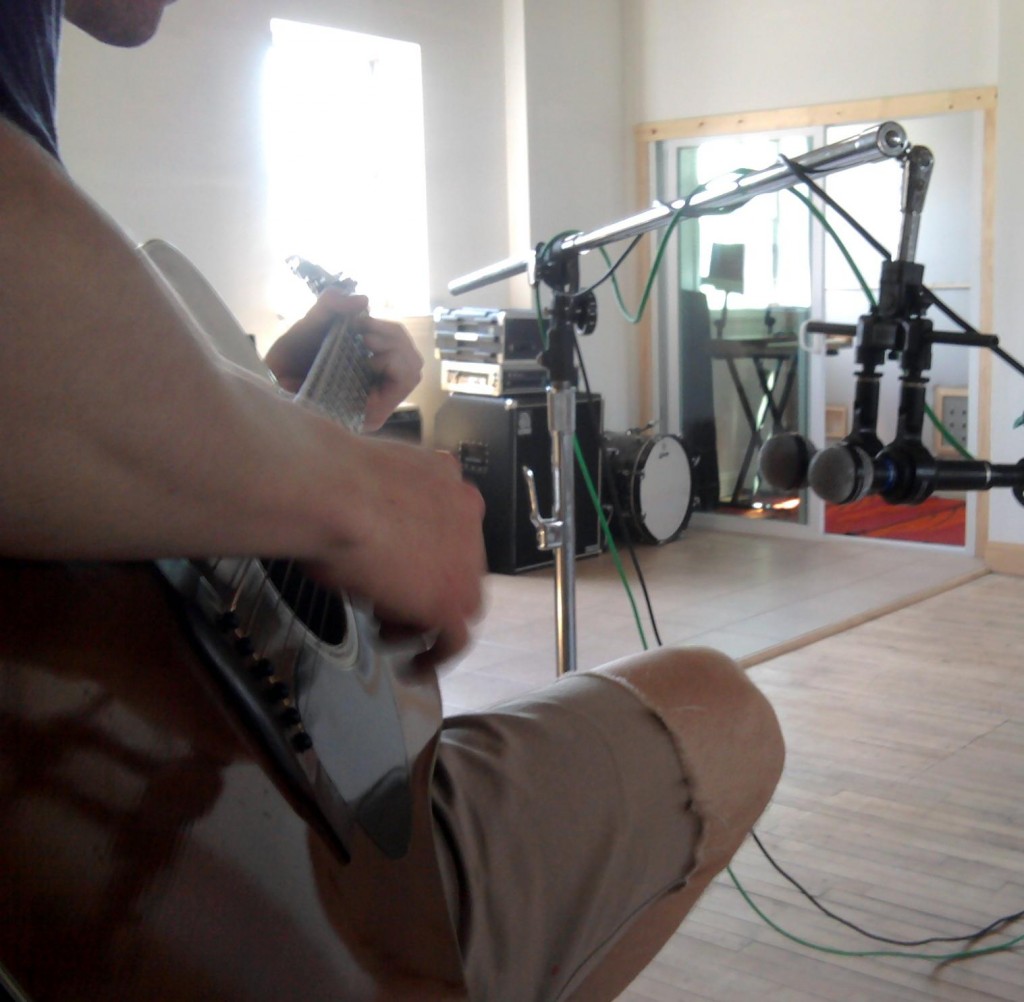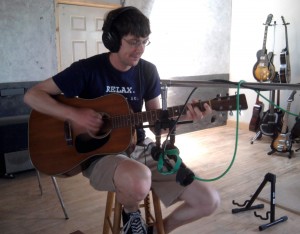 Alright! So earlier this week I described the successful completion of the RCA OP-6/BA-2 microphone preamp. Check out this previous post for all the construction and technical details. The short story is: the RCA OP-6 is one of the most fetishized vintage mic preamps out there; I have always wanted to try one out; the easiest/cheapest way for me to do this was to build one (or at least as close as I could get). The problem is that the input stage requires a special attenuator device, exact values unknown; therefore I had to substitute an input stage from another device. I chose the input stage from the RCA BA-2, as I have built many of these and they always work great. The result: a hybrid of the OP-6 and the BA-2.
Alright! So earlier this week I described the successful completion of the RCA OP-6/BA-2 microphone preamp. Check out this previous post for all the construction and technical details. The short story is: the RCA OP-6 is one of the most fetishized vintage mic preamps out there; I have always wanted to try one out; the easiest/cheapest way for me to do this was to build one (or at least as close as I could get). The problem is that the input stage requires a special attenuator device, exact values unknown; therefore I had to substitute an input stage from another device. I chose the input stage from the RCA BA-2, as I have built many of these and they always work great. The result: a hybrid of the OP-6 and the BA-2.
 OK so there it is. Anyway, the very helpful+generous TW came by to help me out on this one. I wanted to try the OP-6/BA-2 Hybrid (hf. OBH) on a couple of different sources with a couple different types of mics. We a/b’d the OBH with an API 512. I use the API 512 as a benchmark for mic-pre shootouts because it’s a high-quality unit that many people own and use regularly. What you are about to hear are identical mics tracked through the two different preamps, direct to Pro Tools via a Lynx Aurora. Levels were matched. No other processing, level adjustment, or manipulation was done. You are hearing exactly what came out of the preamps. To appreciate the differences between the units, you will need to listen to these files on good headphones or a full-range speaker system. If you listen on a system with a subwoofer (we used the Blue Sky system at Gold Cost Recorders), you will hear some dramatic differences.
OK so there it is. Anyway, the very helpful+generous TW came by to help me out on this one. I wanted to try the OP-6/BA-2 Hybrid (hf. OBH) on a couple of different sources with a couple different types of mics. We a/b’d the OBH with an API 512. I use the API 512 as a benchmark for mic-pre shootouts because it’s a high-quality unit that many people own and use regularly. What you are about to hear are identical mics tracked through the two different preamps, direct to Pro Tools via a Lynx Aurora. Levels were matched. No other processing, level adjustment, or manipulation was done. You are hearing exactly what came out of the preamps. To appreciate the differences between the units, you will need to listen to these files on good headphones or a full-range speaker system. If you listen on a system with a subwoofer (we used the Blue Sky system at Gold Cost Recorders), you will hear some dramatic differences.
 OK. So first up: let’s listen to the drum kit above. These are vintage ludwig drums, 30″ kick, 12″ and 14″ toms, 14×5 wood snare. Cymbals are fairly dark old Zildjans. You are hearing two identical Shure SM-81s placed right next to each other, approx 8 feet in front of the kit, pointed directly at the kit. The 10db pads on the SM81s are engaged. The SM81 is not the prettiest sounding mic, but they have a very flat frequency response.
OK. So first up: let’s listen to the drum kit above. These are vintage ludwig drums, 30″ kick, 12″ and 14″ toms, 14×5 wood snare. Cymbals are fairly dark old Zildjans. You are hearing two identical Shure SM-81s placed right next to each other, approx 8 feet in front of the kit, pointed directly at the kit. The 10db pads on the SM81s are engaged. The SM81 is not the prettiest sounding mic, but they have a very flat frequency response.
First: here’s the API 512:
LISTEN: Drums_API
…and here’s the OBH:
LISTEN: Drums_RCA_hybrid
Our impressions were as follows: the OBH has more low end extension. On the Blue Sky system, the kick drum in the OBH signal moved the room in a way that the API simply could not. The API seemed to move the kit a little closer to the plane of the speakers, but at the same time the top end was not as in-focus. There is a definite low-midrange boost going on with the API. I can say this with relative confidence because I measured the frequency response of the OBH and it is totally flat from 15Hz – 10K, with only a very slight raise above 10K. In terms of operation: the API gain control was at 3 o’clock; the OBH was at 9 o’clock. WOW that is a lot of gain.
 Next, let’s listen to some acoustic guitar. TW played an old Martin D-19 (same as a D-18) that i mic’d with a well-matched old pair of Beyer M260s ribbon mics. The M260 has a built-in gentle roll off that starts at around 200hz
Next, let’s listen to some acoustic guitar. TW played an old Martin D-19 (same as a D-18) that i mic’d with a well-matched old pair of Beyer M260s ribbon mics. The M260 has a built-in gentle roll off that starts at around 200hz
 Alright so take a listen. First, the API 512:
Alright so take a listen. First, the API 512:
LISTEN: AcGtr_API
…and now the OBH:
LISTEN: AcGtr_RCA_Hybrid
Our impressions were that the OBH had more low bass but less low mids; it had a more ‘mellow’ feeling. The OBH also had better high-end extension. This also resulted in slightly more HVAC (air conditioning) room noise in the OBH. Although I like the sound of the OBH again here, it is less of a clear-cut choice. The mid-boost that API seems to deliver is very welcome in this particular setup.
In summary: TW put it this way: ‘(the OBH) is like a pair of gentle shelves (shelving EQs) on the very highs a lows.’ I think this is very accurate. The OBH seems to give what I think of as an English sound: that sort of larger-than-life, hyper-real sound that UK records have always aspired to. I highly encourage your DIY’ers out there to give this project a shot; you will find it to be a very useful tool.
Thanks again to TW for his help with this listening test; T’s band THE STEPKIDS is just back from LA where they did a direct-to-vinyl (!) live set in front of a studio audience (!!!) at Capsule Mastering Labs. Check out the details of this very cool endeavor here and here.
9 replies on “RCA OP-6/BA-2 Hybrid Mic Pre Amp: Listening Test/Shootout”
Thanks for putting this listening test and results together – very useful.
I’m still working up to my Altec 1566 project, but some kind of RCA endeavour may be a good follow-up if I succeed on the first outing.
First thing is to get my old Presto Pre’s up and running.. slowly slowly.
Keep up the great work.
[…] was a high output ribbon with a high gain 6j7 pre. I found an audio demo of an RCA OP6 clone at RCA OP-6/BA-2 Hybrid Mic Pre Amp: Listening Test/Shootout | Preservation Sound I heard it and the host said it "moved the room" unlike the other pre he'd compared. I'm […]
Hi Chris, after listening sound here, I build one.
This things sounds great, and loud, great for ribbon.
Used UTC ouncer for input
And used Gates SA-70 first stage (just cause I build sa70 bunch in past)
Other I followed your info, Edcor, Jensen choke.
Little noise problem at first, but now gone. Thank you again for great info.
Thinking about next might be 76>76>6C5 mic pre.
Hi Sho. Wonderful to hear this from you. Nothing could make me happier than somone actually putting this arcane information to good use. I am not familiar with the 6C5; I know the 6C6. The 6C6 is the older 6-pin version of what became the 6J7 aka 1620 aka 6SJ7 aka 5693.
I been interesting in old 8pin tube pre sound as mic pre.
So your OP6 article helped alot, thank you.
6J7, 6SJ7 I love them both, but somehow not cheap in here Japan.
6c5 was used alot in old Gates amps like Sa70
And little cheaper 6J7 or sj, so I use 6C5 reguilarly
Think EMMR knows alot about Gates, he loves Gates seems.
Now I am interesting in 5pin tubes sound, like 76 as mic pre.
Any plan for post sound test of your 76 pre?
That one looks so cool and love to hear the sound.
Hello sho- i actually use the “old 76” preamp on every session that i do at Goldcoast Recorders. It it my standard top-snare mic using an old shure sm56 with a 20db barrel pad attached to the mic. It sounds wonderful. I made the “old 76″‘so long ago that i cannot recall the exact circuit, but in think that it is 1) jensen 115 transformer into 2) 76 tube with 2200 ohm cathode resistor, 100k plate res, 3) volume pot, 4) some sort of configuration of a 6sl7 tube that resolves with a cathode follower, 5) edcor 15k: 600 output trans. C.
Thank you for your input.
Gee, I better start putting 76 pre together very soon.
You and your site rocks !
This is a nice write up. How do I find the values for all the caps and resistors. There is no voltage or polarity for the caps needed, and no wattage ratings for the resistors. Also there are a few resistor ratings missing. How do I find this info? Is there a better schematic our there that will help?
Thank you
Scott
Amazing!
Wonderful work